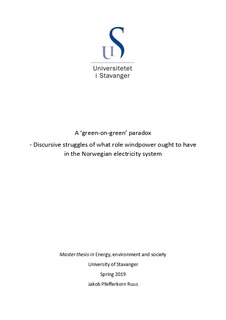| dc.description.abstract | In 2010, Norway had a goal to attain 3 TWh of windpower that was not reached. Recent years, the Norwegian windpower generation has increased dramatically, with yet projects to be built. Whereas almost 4 TWh was produced in 2018 and a planned theoretical production of about 13 TWh in total. But, as the windpower generation increase despite that there are no set goals, this begs the question of why Norway need windpower and what its role is in their electricity system? This thesis is a discourse analysis of relevant actors’ main perspectives on what role windpower ought to have in the Norwegian electricity system. The main findings are two derived discourses. The perspectives that has been retrieved from the data collection, that advocates windpower are visions on electrification processes, increased exportation of electricity, and local value creation. Perspectives that advocates against windpower are windpower’s ruining of untouched nature in terms of human experiences such as outdoor life and tourism industry, and degrading of nature in terms of biodiversity, fauna, flora, etc. This thesis takes an argumentative approach and establish storylines to investigate the argumentative structures. The content is interpreted as well as how actors gain support for their view and how it influences decision-makers.
The discourses are called “Opportunism with windpower” and “Destruction with windpower”. It turns out as a struggle between climate and the natural environment, hence a paradoxical ‘green-on-green’ battle. Most discursive authority is found in “Opportunism with windpower”, but an increasing challenge for discursive authority is opposed by “Destruction with windpower”. An unanimity is found between the discourses, that emissions must be reduced. Should windpower be part of the Norwegian electricity system, its role is mainly to reduce emission. But, whether windpower proposes the quality to fill this role or if windpower’s interference in nature is too severe compared to a limited contribution in mitigating climate change, remains a struggle. | nb_NO |
